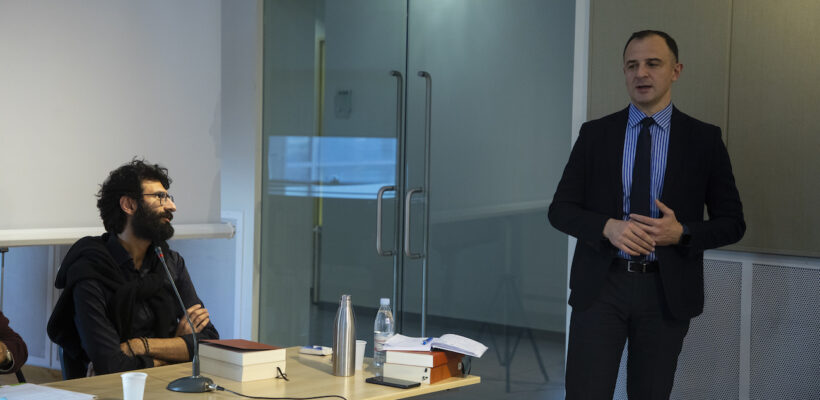
CHSS Hosts Discussion on Israel Ori and Nerqin Grots Book Series
3 min readYEREVAN, Armenia — On November 6, the College of Humanities and Social Sciences (CHSS) of the American University of Armenia (AUA) and the Ashot Johannissyan Research Institute in the Humanities co-hosted the second session of their jointly organized discussion series on research projects implemented at the Johannissyan Institute. At the core of these research endeavors is the express intent to tackle complex issues of modernization within Armenian social and cultural life.
This second panel discussion in the series covered Ashot Hovhannisyan’s Israel Ori and Nerqin Grots Book Series and featured Dr. Ashot Grigoryan, an independent researcher, and CHSS Adjunct Assistant Professor Dr. Ashot Voskanyan.
Assistant to the AUA President on Academic Affairs and Associate Professor in the College of Humanities and Social Sciences (CHSS) Dr. Vahram Ter-Matevosyan opened the event with a warm welcome to all the attendees. He then elaborated on the purpose of the gathering, particularly delineating the significance of the book discussions that CHSS has organized, while highlighting the invaluable contribution of the Johannissyan Institute in reference to the publication of over 10 books in a relatively short time. Dr. Ter-Matevosyan expressed his firm belief that these works are poised to become essential literary resources for academic institutions in the near future, emphasizing their profound importance both in terms of the relevance of topics and meticulous attention to detail in the text.
Dr. Grigoryan then took the floor and expressed his gratitude for the kind introduction, then provided a deep insight into the book. He elaborated on the series’ title Nerqin Grots, explaining that it carries historical connotations related to the ‘Artaqin grots’ initiative that translated informative Greek works into Armenian. He highlighted the intriguing duality of Nerqin Grots, as it diverges from its precursor, focusing on more contemporary works (from the 17th to the 20th century), making them accessible to modern readers. Dr. Grigoryan emphasized that the selected works in Nerqin Grots‘ offer the opportunity to delve into Armenian history, shedding light on elements that are integral to everyday life but have been previously overlooked.
Dr. Grigoryan introduced the first volume of the series, “Israel Ori and the Armenian Liberation Idea,” which is the Armenian translation of historian and politician Dr. Ashot Johannissyan’s Ph.D. dissertation, defended in Germany. Dr. Grigoryan added that the volume is enriched with Johannissyan’s working notes and extensive editorial commentary, allowing readers to trace the development of the dissertation and providing a fresh perspective on transitional historical figures. He underlined Johannissyan’s critical and dynamic approach to Armenian history, which he portrays as an ever-evolving force influenced by both internal and external contradictions. Dr. Grigoryan further explained how Johannissyan’s research methodology unveils the intricate evolution of the liberation idea, with Israel Ori emerging as a pivotal figure in this complex process. In his concluding remarks, Dr. Grigoryan emphasized that the objective of featuring this work in the Nerqin Grots series extended beyond simply revealing Israel Ori as a transitional character. It also aimed to spotlight Johannissyan’s skill in scrutinizing Ori, valuing him as a distinct and significant transitional figure.
Dr. Voskanyan continued the discussion by sharing his connection with both books.. He introduced the second volume, a translation of theologian and philosopher Missak Khostikian’s dissertation “David the Philosopher,” originally defended at the University of Bern. Dr. Voskanyan highlighted the significance of this volume in his own research, which centers on David the Invincible. He explained that Khostikian’s dissertation aims to unravel David’s position and philosophical importance within the School of Alexandria and its intellectual tradition. Dr. Voskanyan agreed with Dr. Grigoryan’s observation that while Khostikian’s work served as a starting point for Armenian philosophical inquiry, it was, to a certain extent, a “critical starting point” marked by criticism. He noted that this precarious beginning renders Khostikian’s work distinctive in Armenian intellectual history, which has remained inaccessible in Armenian and whose author fell victim to the Stalinist purges.
Comparing both volumes in the series, Dr. Voskanyan highlighted their broad narratives and role in challenging and extending the existing historical accounts, referencing diverse philosophical sources. Whether by rejecting ideas found in these sources or partially accepting them, Dr. Voskanyan continued, the authors of the volumes suggest that the conclusions they have reached do not solely reflect their own; rather, they represent a collective narrative by the authors of all the incorporated works.
The discussion was followed by an engaging Q&A session, which provided the opportunity for guests, students, and faculty members to delve deeper into the historical context and literary approach of the book.
Founded in 1991, the American University of Armenia (AUA) is a private, independent university located in Yerevan, Armenia, affiliated with the University of California, and accredited by the WASC Senior College and University Commission in the United States. AUA provides local and international students with Western-style education through top-quality undergraduate and graduate degree and certificate programs, promotes research and innovation, encourages civic engagement and community service, and fosters democratic values.
